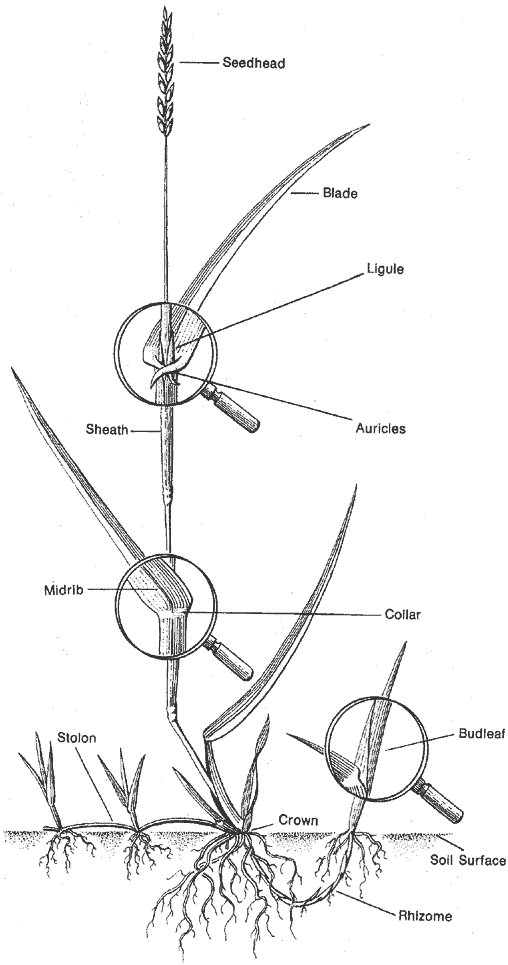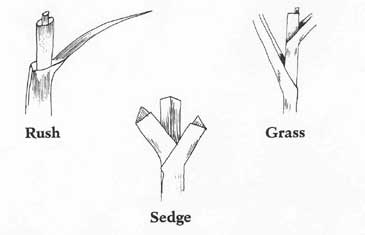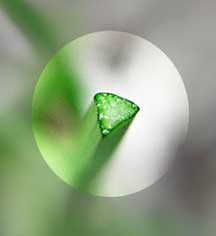How to Identify a Turfgrass
Instructions: The following text describes the process commonly used to identify an unknown turfgrass. Where you see “bold” text. You should refer to some of the associated diagrams for supplemental information.
Why Does Identifying Turfgrasses Matter?
Proper management of a turf area requires correct identification of the turfgrasses on a particular site in order to determine appropriate management practices like: proper mowing height and frequency, fertilization needs, irrigation, and if needed pesticides. Often the turfgrass species that are present are not necessarily what was originally planted but are reflective of the cultural practices and prevailing growing environment. Together these two factors influence shifts in the turfgrass community of one species over another, which may affect management practices.
Identifying a Turfgrass: The Process
Identifying turfgrasses is much like solving a puzzle. Several pieces or identifying characteristics are viewed, their exact nature determined and the species identified. Unfortunately, no single characteristic or feature alone is sufficient to determine with complete certainty a particular turfgrass species. The first step in the identification process is to confirm that the plant in question is actually a grass and not a sedge or rush. Grasses have their leaves arranged in ranks of two (see photo/diagram), and a ligule is often present. By contrast, sedges and rushes have leaves arranged in ranks of three, and the ligule is poorly developed or absent. Another distinctive sedge characteristic is their triangular shaped stem (see image). Remember, the adage “sedges have edges”, thus they are not grasses. Sedges and rushes form an unreliable, poor quality turf that does not persist. These species are not normally cultivated as lawn species and are considered weeds.
Determining Vernation
Once it is confirmed that the plant species you are trying to identify is actually a grass species, the next important characteristic you need to determine is the appearance of the youngest unexpanded leaf. The newest leaf of a turfgrass plant always arises from the center of the shoot and can be located in the newly expanding bud leaf/shoot. The orientation of newly emerging leaf is called vernation. This characteristic is difficult to determine on older leaves because they are located on the outside of the shoot and have expanded making vernation difficult to determine. For most turfgrasses, the vernation will either be rolled or folded. For some turfgrass species like bermudagrass, vernation can be variable, meaning that sometimes this plant may appear somewhat rolled rather than folded. Although not a perfect diagnostic method, one method for quickly determining the vernation is to pick up a mature tiller from the plant or turf area in question. Place this plant between your thumb and fore-finger and attempt to spin it between your fingers. If it spins readily then the grass is most likely rolled, if it is difficult to roll then it is probably folded. If this method still leaves you still uncertain, another more quantitative or precise method is to cut a cross section of the shoot with a razor blade or other sharp instrument. Be sure to cut the emerging unexpanded leaf blade just below the point where the unexpanded leaf blade is emerging from the shoot. This should clearly show if the newest leaves are rolled or folded.
Studying the Leaf
The next part of the plant you should carefully study is the leaf blade. A small 10x magnifying glass may help when determining its features. The leaf consists of a lower sheath, which surrounds the stem or crown above the node from which it originates. Emanating out from the sheath is the newly expanded leaf blade which you observed for vernation. There are four very important features located where the leaf blade and the leaf sheath join. The most commonly visible feature in this region is called a ligule. If present, it will appear a small piece of membranous (nearly clear cells) tissue or other appendages like hairs that projects upward. Additionally, these ligules may be short, tall, or medium. All of these ligule characteristics are important identifying characteristics. The next features to be looking for are called auricles, ear-like appendages that if present will clearly project from either side of the collar. Like the ligule, auricles will either be absent, barely visible, termed “rudimentary”, or very prominent, termed “claw-like”. The third feature to study is called, the collar, a thickened zone of yellow-green colored tissue located on the backside of the leaf where the blade and sheath join. Of the three identifying features, the collar is one of the most variable and least reliable identifying characteristics. Therefore, identification should not be solely determined based on the appearance of the collar without viewing additional characteristics. The last feature, which was mentioned earlier, is called the sheath, located between the crown of the grass plant and blade. The sheath may be split-open, split, with overlapping margins or completely closed.
Examining the Leaf Tip
The appearance of the leaf blade itself holds many clues as to which turfgrass you may be identifying. The leaf tip and upper and lower leaf surfaces can also be very helpful. Leaf tips may be pointed, rounded or boat-shaped. Often the leaf tips of closely associated turfgrass species are similar, for example the presence of a boat-shaped leaf tip indicates that the grass is probably one of the bluegrasses. On the back side of the leaf blade a mid-rib may be present and the leaf blade may be glossy or shiny or dull. Ryegrasses generally have pointed leaf tips and glossy undersides of their leaves. The prominence of veins in the leaf blade and their physical expression on the leaf surface may cause the upper surface to appear smooth or ridged. This too can be helpful.
The Seedhead
For scientists that botanically classify plants, the careful observation of a plant’s seedhead or inflorescence is essential to identification. Since most turfgrasses do not produce seedheads throughout much of the year and regular mowing removes seedheads this characteristic is not normally used for identification. Should the seedhead be present it will normally appear as a raceme, spike or panicle. Like with the leaf-tip, the seedhead, may help narrow a grass down to certain families. For example, bentgrasses and bluegrasses have panicle shaped seedheads and ryegrasses have spikes.
Growth Habits
One of the last features growth habit, requires a relatively mature turfgrass to determine. Turfgrasses will either be bunch-type or spreading. Spreading grasses have lateral creeping stems that if above-ground, called stolons or underground, called rhizomes. Some turfgrasses have only one type of stem while several like bermudagrass possess both rhizomes and stolons.
Limitations to This Process
Successful identification of turfgrasses depends on a detailed examination of a number or representative plants from the area you are trying to determine. The species composition depends on cultural or management practices and growing environment. These factors need to be considered when sampling plants used for identification. Often the dominant species growing in the front of a home or building might not be the same as in the back. For example many landscape contractors often plant a utility sun/shade seed mixture consisting of Kentucky bluegrass and fine-leaf fescue. If the home has a sunny front lawn and shady back-yard, over time the species composition will change. The sunny front lawn will likely be dominated by Kentucky bluegrass and the shady back-yard will probably be dominated by fine-leaf fescue. This is because Kentucky bluegrass thrives in full-sun conditions whereas fine-leaf fescue is more competitive in shade. Where the sun and shade transition, the species will probably be evenly mixed. Therefore, you cannot simply have a pure Kentucky bluegrass or fine-leaf fescue lawn. The last factor to consider is the fact that there are more than 170 Kentucky bluegrass cultivars all with unique characteristics like leaf color, texture and density. When selecting plants for identification it is important to select the most healthy turf plants possible. Plants grown in moist habitats have larger, greener, and less hairy or rough surfaces than plants of the same species being grown in a droughty environment. With that in mind, mature, actively growing grasses will be easier to identify than wilted, or partially dried or damaged plants.


